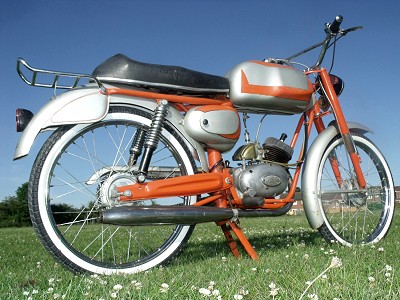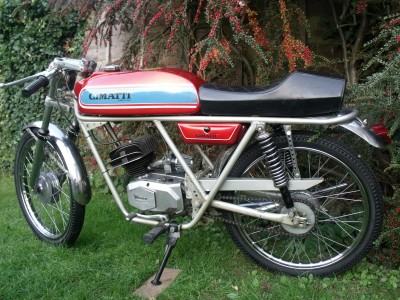In 1907, Angelo ‘Guido’ Gatti left his position as a manager at Bianchi, to establish his own bicycle manufacturing plant at Milan in 1908, which he called Atala, in honour of his mother, Atala Naldi.
The Atala brand immediately became a direct rival of Bianchi, who wanted to begin an Italian equivalent to the Tour de France in collaboration with the newspaper Corriere dell Sera. Gatti however, found out about this idea, and brought the story to the pink pages of La Gazetta dello Sport who undercut Corriere dell Sera and began the story of the Giro d’Italia themselves.
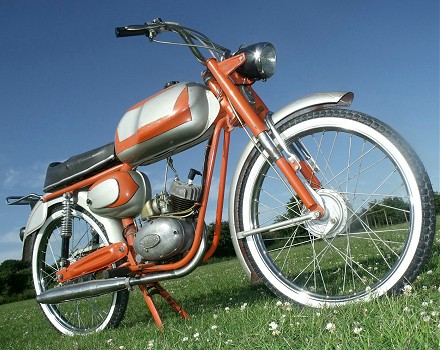
Since the beginning of the 20th century, Gatti supported his factory cycle racing team by participating in the first editions of the Giro d’Italia, and Atala got its first big break with Luigi Ganna winning the first Tour of Italy in 1909, then followed in 1910 by Carlo Galetti, who was also riding for the Atala team. The 1912 Giro d’Italia was an unusual competition for teams rather than having an individual winner; Atala was the winning team.
In 1916 ownership of the Atala company was transferred to the Società Artale & C, and in 1916 passed on to SA Emerico Steiner who took over the directorship and, although Gatti had produced bicycles under the Atala name since 1908, the brand wasn’t actually formally registered by Emerico Steiner until 1921!
Atala built its first motor cycle in 1923 as a 124cc two-stroke with a horizontal cylinder, then started producing a further range of motor cycles from 1924, mainly based on British JAP and Blackburne engines. No explanation was given when motor cycle production ended in 1934, but was probably related to Nazionale Fascista Partito ideals at this time ‘discouraging’ imported products in favour of home-produced manufacture, though compatible proprietary Italian engines were probably not available.
Cesare Rizzato was a craftsman frame builder in Padua. From 1921, he began to produce cycles under the Ceriz brand (an acronym formed from his name). He was joined in the business by his brother Alessandro when the company was registered as Cesare Rizzato & C SpA.
In 1938, Atala was bought by Cesare Rizzato & C and continued building bicycles at the production facilities of the purchased factory, then returned to making Atala Rizzato branded mopeds, scooters and lightweight motor cycles from 1953.
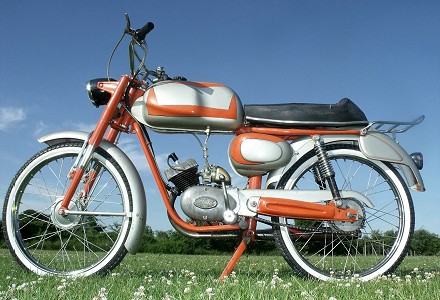
Although the Atala Cesare Rizzato 112 Sport model was listed for UK sale, our example was Italian registered from its home town of Padova on 26th March 1966, with full accompanying original Italian documentation, and it looks as if 1977 was the last time it was used! The ‘customer’ engine side badges on the clutch and magneto covers bear the names C.Rizzato–Atala, but the motor was made by Minarelli, Dimensions are given as 39.4mm bore × 41mm stroke for 50cc, rated 1.1bhp at 4,000rpm, though this is figure is fairly meaningless since it’s obviously taken at low revs, and would be much greater at higher rpm. The engine has three-speed hand-changed gears, with a left-hand forward-action kick-starter mechanism, which is obviously a development from a pedal-started moped unit. The plain front of the crankcases is a notable departure from the earlier type the UK saw fitted in Kerry Capitano models, which displayed inset fins in the front of the case. Gear cable anchor points are also located differently on the top of the crankcase, and the slightly larger cast aluminium cylinder head bottom fin overlaps the cylinder barrel.
This appears to be an engine version we didn’t see much in the UK.
The carburetter is a Dell’orto SHA 14–12 fitted with F–27 type filter box, which is particularly effective at suppressing induction noise. The shutter choke clicks on by pressing down a small lever on the back right-hand side of the carburetter body; it will release its latch automatically when the throttle is opened wide.

The bike appears to be in completely standard trim and finish, so looks like a very genuine example of its type.
The styling is an odd mix of sports and street cruiser, which looks as if it might have been intended for American market appeal. It has original silver and orange paintwork, and the model’s most immediately distinguishing feature is certainly the quarter-valance panel on the sides of the rear mudguard, presumably intended to reflect a competition style of mounting race numbers. Beyond this feature, the rest of the cycle fittings appear to be standard Italian market ‘parts bin’ components. You see the same fuel tank and toolbox on lots of period Italian brands, electrical fittings are all Aprilia, and the headlamp still wears its original Aprilia speedo blank, so it’s obviously never carried a speedometer. For those that may not know, Aprilia started by making proprietary electrical accessories, and then later graduated to building their own complete motor cycles.
2.00×19 wheels & tyres with 36-hole Westwood pattern rims are laced into what appear to be general market galvanised full-width hubs around 100mm diameter brakes.
The front forks, rear swinging-arm and suspension units, chain guard, Domino controls, and Lafranconi exhaust system continue the proprietary fittings, as presumably does the fastback-style, mattress-sprung saddle, which is hard as a board. While its 15-inch pad might have been intended as a cosy two-seater for not-so-large people, there are no rear footrests fitted so maybe this bike was only used as a solo?
Mounted off the rear frame, a small chrome plated tubular steel carrier trims the rear mudguard behind the seat. At just 11 inches long by 6½ wide, this is no wider than the saddle and kicks up at an angle at the back to finish only an inch beyond the rear lamp, presumably to give some thoughtful and neat protection against backing into walls—clearly one of the few dedicated fittings.
Time to give it a try, so turn the fuel tap (off–on–reserve), snap down the choke, and try a couple of kicks. These fail to return any result, so we scoot down the road, snick the shift into second, and it starts straight away. Clutch in, back to first, and sit running to warm at low revs … we note the smoke floating gently out of the back of the silencer, but it sounds unusually quiet, so we open up the throttle to unlatch the choke, then a couple of blips on the twistgrip to clear the tubes. Twist into first, then up to second, round the corner and briefly up to third, all the gears seem to be there, so straight back to base to await the opportunity for a clocked test run around the track.
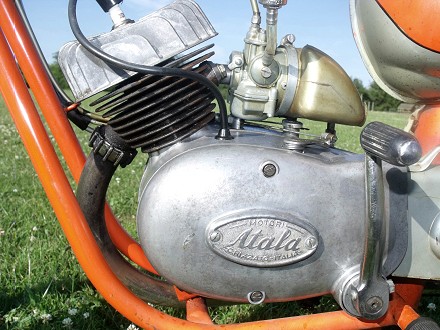
A couple of days later our pacer becomes available, and this time the motor manages to start on its second kick, and as we sit ticking over to warm, it still seems eerily quiet, and again we note the smoke drifting gently from the exhaust, so open up the throttle to unlatch the choke, then a couple of blips on the twistgrip to clear the tubes. Twist into first, then up to second, into third, and very quickly we realise we seem to be lacking performance! Atala struggles to pull third even with the throttle wide, response—isn’t! This seems to be terribly restricted, but we persevere in the hope it might clear when the engine warms up … no it doesn’t. This clearly doesn’t feel right, but we try a fast run anyway just to get a marker of what it does. That answer to that is slow and more slow.
Returning to the pits we get the pacer’s report, just 22mph on flat, to a peak of 29mph through the light downhill section, with a lot of white smoke coming out of the exhaust, so it’s back to the workshops to check this out. That motor couldn’t push its way out of a wet paper bag, it ran suspiciously quietly, so maybe we’d better look at the exhaust? Pull out the baffle, but the end seems clear, so off with the silencer… and maybe that feels a little heavier than we might expect?
Could it be blocked, maybe a possibility, so we stand it in a pan-tray and pour some petrol in the top, and wait … and wait … for something to come out the other end … no? Maybe a little more petrol? And still we wait … for just a small oily drop. Well, that seems to be the problem then.
After a cold burnout with an oxy/acetylene and air-compressor line to save bluing the chrome silencer, we put it all back together to try again. This time the motor starts first kick, the exhaust sounds rather more vocal, and now seems to breathe its smoke clear. A brief spin down the road quickly reveals a remarkable transformation has taken place, so just three hours later we return to the track for a re-run.
This time acceleration is much improved, and the motor pulls well in all gears, to pace a best holding 39mph on flat in a tuck with a following tailwind down the main straight, and exactly the same 39mph through the light downhill section, so the motor is now revving out its top gear.
We conclude that Atala must have selected a lower drive ratio (probably by 1 tooth fewer on the front sprocket) than the three-speed Kerry Capitanos we previously tested with similar three-speed Minarelli engines. The over-geared Capitanos could achieve around 45mph under favourable conditions, but struggled to pull top gear against adverse conditions, and became particularly annoying with the constant changing up and down from third to second since their motors failed to produce enough power to overcome the high ratio.

Atala selected the 112 Sport ratio in a more practical all-round range, but it staggered us to consider that someone had actually ridden the bike for years to the point where the exhaust was so completely blocked that the bike would barely go!
The brakes worked adequately, though the rear drum squealed loudly at every application. Handling was OK within the limits of the bike’s performance, the ‘cruiser’ riding position with its trials-style handlebars was comfortable and practical for general road use, but the seat was about as forgiving as bouncing on a park bench.
Lights that were reportedly working didn’t appear to do so when we tried them, and the further lack of a horn seemed to suggest maybe a wire was off somewhere.
Other famous cycle brands taken over by Cesare Rizzato include Maino and Dei. Established in 1896, Maino is one of the oldest bicycle producers in Italy. Maino also operated an Italian professional competition cycling team that existed from 1912 to 1936, with riders of the team winning four editions of the Giro d’Italia. Maino was the bike on which Constant Girardengo and Learco Guerra won the 1931 World Championship in Copenhagen, and was also the first racing bicycle of Fausto Coppi.
The official colour for the Maino racing team bicycle was grey.
Umberto Dei was already an apprentice mechanic when he started his career by founding his own cycle company in 1896, but his limited financial means meant he initially had to settle for mainly building frames for local merchants and racing bikes for his friends and companions, who would cover the cost of the tubing and building materials in advance, but the quality of his workmanship and competition results quickly established him as a recognised name in Italian cycle racing.
In 1897 Umberto Dei was selected by the UVI and sent to Paris along with three more of the best Italians to take part in a race against the most well-known French racers of the time. The Italians won the competition with Umberto contributing very effectively to the overall result on one of his own cycles, with a second placing behind Minozzi, the then Italian Champion.
From this time leading professional Italian and foreign racers began to approach Dei for the construction of special competition bikes and, by 1901, Umberto found himself with a leading role in the track World Championships held in Berlin.
The level of quality and perfection of Dei racing cycles was so high that the brand became world renowned, the brand won everywhere, and for nearly half a century was consistently competing at the top of the field.
At the ANCMA Milan bicycle trade fairs, from 1929, Dei would display his bikes hanging from scales, demonstrating they were lighter than his competition, and with signs and descriptions of the special lightweight alloys employed and other detailed particular component weight saving measures without compromising the structure and durability of the bike.
During World War 2, Umberto Dei had both his complete production facility and most of his home destroyed by a bombardment in 1943 but, despite his advancing age and loss of most of his assets, he was able to re-establish himself in new premises at Via San Vincenzo after only a few years, and soon returned his brand to the limelight.
Umberto died in 1964, after which the Dei brand was bought up by Cesare Rizzato.
Rizzato Cesare & Co continued with Atala, Maino, and Dei branded cycles, some small capacity moped and motor cycle production, and electric powered cycles until 21 May 2002 when, following a dramatic decline in the European cycle market, it was sold by the Rizzato family to the TIM International SA financial group of entrepreneurs in Milan, and the Banca Antonveneta. The company was reformed into Atala SpA.
Later taken over again by the Dutch multinational Group Accell, the Atala brand still appears on traditional bicycles, electric pedal assisted cycles, a complete line of accessories, and home fitness equipment. The Umberto Dei brand continues in the retro-bike market; and the Maino brand is used on assisted bicycles, urban and mountain bikes.
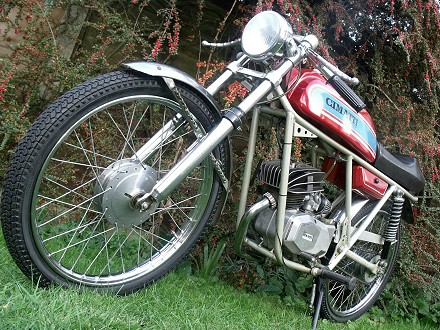
And now, Back to the Track again, with another Cimatti…
We previously covered a type S5 Cimatti in the second track day feature, frame serial 271585 dated to 1974.
The type S5 was homologated in late 1969 or early 1970, but now we have an S6 example recently brought in from Italy. This later frame serial 357275 dates to 1979, but the model S6 was homologated in 1972, which means that the two models were being produced in overlapping production for a period.
They seem to employ the same, or a very similar, twin-tube, full cradle frame (which we think was probably made by Verlicchi) and wear the same distinctive reinforcing gussets at the forward junctions.
The heavy-duty 28mm fork stanchions with chrome plated steel legs are mounted in Ceriani alloy yokes, and fitted with chrome clip-on bars with alloy levers mounted into tidy integral lever brackets. A neat alloy PV cursor-throttle control sits discretely on the right-hand clip-on bar, beneath which is a pair of Tommaselli short alloy headlamp brackets mounting a chrome headlamp. The forks are fitted with a 110mm single-sided Grimeca alloy front hub with closed-vent brake plate (just for show), and the overall effect of this front end certainly does look very nice.
The rear hub is a 100mm Grimeca alloy, and both ends are laced into 18-inch chrome steel Westwood pattern rims, with skinny 2.00 tyres, and covered by stainless steel mudguards, with a small tail light at the rear.
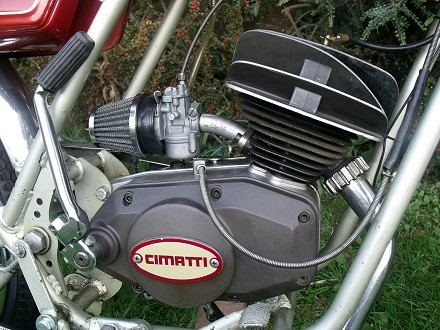
Its Minarelli four-speed engine looks like an early example of the squared crankcases, while the cast-iron cylinder is still a relatively small-fin example. It looks as though someone has been ‘playing’ with the tuning on this motor, since wee can see an alloy ‘lifter’ plate of about 2mm between the barrel and the crankcase to raise the porting, and a big radial-fin alloy cylinder head overhangs the cylinder to presumably give the motor a higher compression ratio and sportier look. The carburetter, however, remains a modest and standard SHA 12/14. The exhaust system however is very clearly a long way from standard: it’s a Marcello Collaro competition expansion pipe; previous experience with these systems tells us this is going to be straight-through and very noisy, definitely not for road use, so it’s going to be straight down to the track with this machine.
The single seat is a sport-style short fastback and lines up to a well shaped tank in original trim, to give an overall well-balanced impression. The Cimatti S6 is certainly a neat little Sports 50cc motor cycle, though with its footrests still in the standard position, so is likely to feel a little cramped for the riding position with its clip-on handlebars beneath the top yoke.
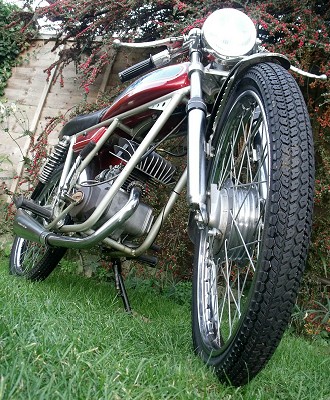
After cleaning out the carburetter and fettling a few details, the bike is readyt to go back into service. The fuel tap is tucked beneath the left-hand back of the tank, back for off—down for on—forward for reserve. Click the choke strangler latch on the carburetter, which will automatically snap-release when the throttle is opened full, then a few firm jabs at the kick-start find a couple of splutters, before gargling into life and firing out bursts of smoke. After about 30 seconds we try opening the throttle to clear the smoke, but the motor threatens to peter out, so we click the choke back on to give things a little longer to cook.
After a little while longer the choke-running feels to be clogging up, so we release the choke and blip the twistgrip to clear. There’s certainly a snappy response to the throttle, accompanied by a lot of smoke and ferocious crackling from the expansion tailpipe, so we navigate out of the garage and warm the engine out in the pit lane.
Having no speedo fitted, we’re followed by our pacer around the track. Leaving the pit lane into the shallow uphill section, we briskly accelerate up through the gears and crest onto the circuit easily pulling 38mph, then clocked on sat-nav pulling up to 42mph tucked in along flat sections, and touching 50 running down though the long dip.
This seems pretty good considering our S6 is only fitted with a standard 12mm carb. The gearing ratios feel quite low, and the motor pulls strongly in every gear, then sounds to be revving out, but that’s obviously not the case. It’s easy to gain a false impression with a particularly noisy and unsilenced expansion exhaust like this, and the motor’s limiting factor on flat is actually being under-carb’d. The fact that it gains another 8mph through the dip every time around the circuit shows it’s definitely got more revs to go, but can’t achieve the power on-flat due to limited carburetion.
The exhaust noise was quite offensive just from the rider’s point of view, but our pacer reported he felt as if he was in the firing line of an anti-aircraft gun.


